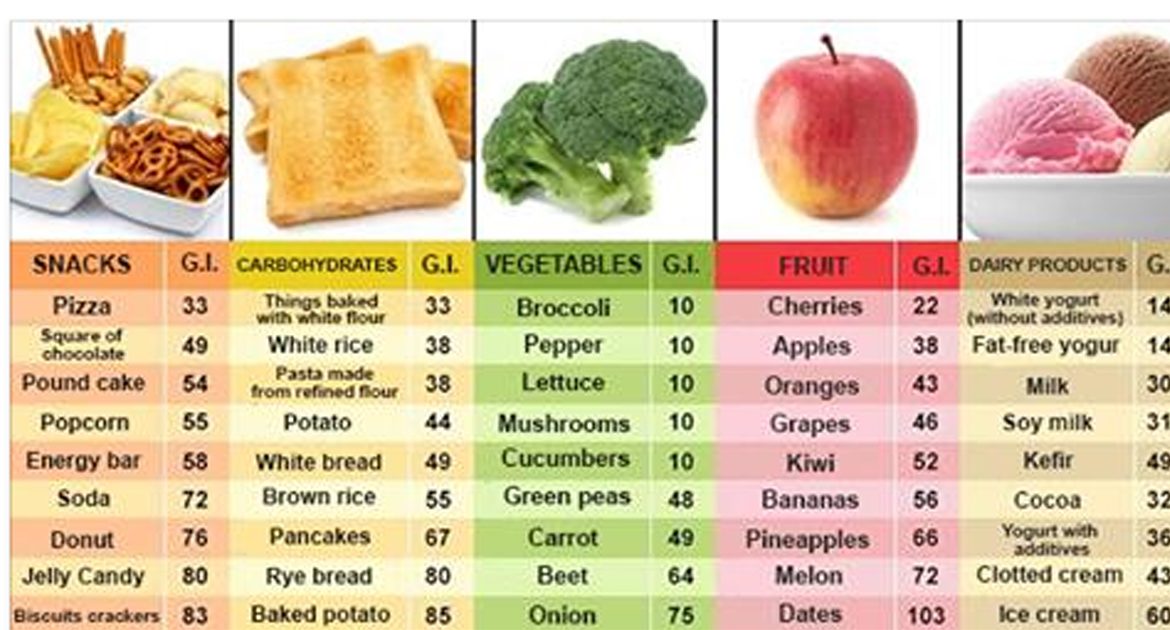The body of a healthy person independently maintains blood sugar at the proper level. However, stress, unbalanced diet and a sedentary lifestyle have their negative influence, and the number of people who suffer from diabetes increases year after year. For those of you who wish to keep their blood sugar levels optimal, it is best to avoid foods that are high on the glycemic index (GI). As a general rule, the more ripe, cooked, or processed a fruit, vegetable is, the more likely it is to be higher on the GI. The key offenders include — bananas, pineapple, watermelon, carrots, parsnips, mashed or russet potatoes.
The glycemic index is a way of quantifying the effect of foods on an individual’s blood glucose level. The numbers of the index, which represent a rise in blood sugar levels two hours after eating foods, range from 0 – 100, with 100 representing pure glucose.
Foods containing carbohydrates that break down quickly will have a higher GI number than foods that require more time to break down the carbs. In general, it’s probably best to avoid foods that are high on the glycemic index if you are watching your blood glucose levels.
Keep in mind that the glycemic index is not perfect, nor was it intended to be. For instance, it does not take into account the insulin response, which could be different from person to person, and is measured by the insulin index.
Foods on the glycemic index scale are broken down into 3 groups.
On the lower end of the range from 0 to 55, we have vegetables like broccoli, cabbage, onions, and lettuce. These foods are considered very low, with a GI of around 10. Examples of fruits from the low range include cherries, grapefruit, and prunes. Creeping up the scale, vegetables such as dried chick peas and kidney beans check in at around 28, while apples, plums, and pears are getting close to 40.

Medium range glycemic foods include mangos, bananas, kiwis, and pineapples, as well as boiled potatoes, sweet potatoes, and sweet corn.
High Glycemic Index Fruits And Vegetables
We’ve always been told that fruits and vegetables are among the healthiest things we can eat, and for the most part, that’s true. The recommended daily amount of fruits and vegetables for optimum health is 5–9 per day. There are, however, some fruits and veggies that are sky high on the glycemic index, and consuming these foods could cause a spike in your blood sugar levels.
Bananas – This is a difficult one to quantify. While the GI number for bananas is 51, they vary a great deal according to how ripe they are. Bananas which are brown and spotted are high in sugar content, and this can push them into the high GI category.
Pineapple – with a GI of 66, pineapple is on the upper end of the medium spectrum. We include it here because fresh pineapple can differ significantly from canned pineapple that’s packed in sugary syrup. Choose fresh when possible.
Carrots – My favorite vegetable, the carrot, makes an appearance on the GI index at 71. I still eat them, though, just in moderation.
Watermelon – The GI of watermelon is 72, putting it in the high category.
Parsnips – Parsnips clock in at a whopping 97 on the GI scale. That’s among the highest for vegetables.
Potatoes – Depending on how they’re cooked and what they’re served with, potatoes can be very high on the GI scale, anywhere from 87 for instant mashed potatoes to 111 for a baked Russet.
Glycemic Index Vs. Glycemic Load

As with almost everything in the world of nutrition, things just aren’t as easy as looking them up on a chart and then steering clear of them. When we talk about the glycemic index, we really need to discuss something called glycemic load as well.
Simply put, glycemic load is an estimate of how much a certain food will raise someone’s blood glucose level. One point on the glycemic load scale is approximately the same as consumption of one gram of glucose.
Glycemic load goes a bit further than the glycemic index. It takes into account the number of carbohydrates consumed when estimating the impact of certain foods. For example, watermelon is high on the glycemic index scale but very low for glycemic load. This is because it doesn’t contain many carbohydrates, so you’d have to consume a great deal to spike your blood sugar level.
Carbohydrates are everywhere, sometimes hiding in foods where you would never expect it. Remember that the glycemic index is important as a guide if you’re watching your carb intake and that the more heavily processed a food is, the more likely it is to be higher on the glycemic index.






